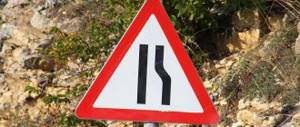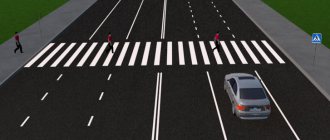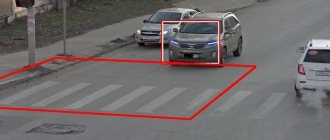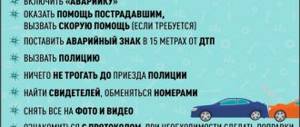roadway
Road Elements
The emphasis in this term is on trackless vehicles.
Tram tracks are not roadways.
- In special cases, the movement of trackless vehicles is allowed on tram tracks, but they are not intended for these purposes. Tram tracks are not located "on the" roadway, and "on the left of" - in cases where movement on them is allowed.
Rails to the left of the roadway"
What is a dividing line
In order to create the safest possible traffic on busy sections of the road, a dividing zone is being established to delimit traffic flows.
Thanks to elevated structures, it is possible to avoid vehicles from driving into oncoming traffic. On highways in Russia this element is mandatory. A dividing strip is a section of road that is separated from the roadway by special markings or structures. This area is not suitable for traffic or parking of vehicles. Often it rises above the main road surface, which is achieved by installing curbs or metal structures. Sometimes the area dividing the roadway is sown with lawn grass or set aside for a tram track. Cars are strictly prohibited from driving on the rails.
Important! The dividing strip is the part of the land along which the movement of vehicles, roads or constructed structures is organized.
Some motorists make the mistake of mistaking a double solid strip for a dividing line. The main difference between the two different markings is the distance between the stripes. In double solid, the interval between elements is quite small (usually equal to the width of one strip). The separation zone can be identified by the following characteristics:
- paved hill;
- lawns;
- concrete fences;
- metal constructions.
In a simpler definition, a median is considered to be the central section of a road, defined by markings or various structures. Other reserve zones indicated by markings have nothing to do with the separating element.
What can happen in the demarcation zone:
- tram rails;
- gaps that allow vehicles serving the road to make turns.
Braking along the dividing strip, driving onto it, or leaving a car on the island is strictly prohibited.
Road lane
From the definitions of “road” and “roadway”, “traffic lane” is the third most nested element of the road.
The main element, the road, includes the roadway, and the roadway element is the traffic lane. Based on these terms, the existence of a traffic lane is impossible without a road. For a long time there was a dispute about the presence of roadways in courtyards and other adjacent areas.
This issue was closed by the decision of the Supreme Court of the Russian Federation in case No. AKPI12-205 dated April 17, 2012, with consideration of the contradictions of the Road Traffic Rules of the Russian Federation and the Convention on Road Traffic. In particular, this decision contains that elements of the road network can be located in adjacent areas.
in adjacent territories there may be elements of the road network (roadway, sidewalk, etc.), the totality of which constitutes a road according to the definition of the term “road” in paragraph 1.2 of the Rules
On the one hand, this goes beyond the strict framework of the elements described in the text, on the other hand, it falls within the logical framework. The adjacent territories are also intended for traffic, road accidents occur there and traffic is regulated by the same rules. Regulatory documents on road construction come into conflict, and then the means of organizing traffic. Sometimes it is impossible to visually distinguish a road and the surrounding area without finding out who owns a specific piece of land. In adjacent territories, roads are not built as linear construction projects, but individual elements can form a road in the context of the Road Traffic Regulations. Other departments that deal with traffic on the road network are responsible for organizing traffic in the adjacent territory.
Returning to traffic lanes, it is also often impossible to mark them according to regulatory documents (for example, ensure a width of 3 meters, mark them with appropriate intersection signs, and so on. But again, in the context of traffic rules terms, there are traffic lanes in the adjacent territories.
Roadway: concept
A roadway is an element of a road or road structure intended for the movement of trackless vehicles.
In addition to motor vehicles, bicycles and mopeds can also move along the roadway (in the absence of bicycle paths), as well as pedestrians (in the absence of sidewalks and curbs or the impossibility of movement on them). A rail track for the movement of railway transport can be combined with the roadway. In the absence of shoulders, the roadway is also intended for stopping/parking vehicles. A road may have one or more carriageways, between which there are dividing strips. Often there are two carriageways, one for each direction, which increases traffic safety.
Sometimes there are four carriageways - two central ones for main traffic and two side ones for local traffic and for stopping/parking. As a rule, each of the roadways has at least two lanes to allow for advance and passing.
Marked or unmarked
From the paragraph above, according to regulatory documents, it is possible to designate only lanes on correspondingly “regulatory” roads. Means of organizing traffic in adjacent areas can also be used, but depending on the situations, their requirements may differ. For example, you can often see the 5.5 sign at gas stations and parking lots. “One-way traffic”, but since there is no “standard” road, it will not be possible to move along one-way traffic in violation. In the same parking lot, on the opposite side, there is a “Brick” hanging - it is no longer tied to the road, and a lawful fine will be issued for violating this sign. You can often find narrow lane markings in parking lots, and no one will issue a fine for violating such markings or driving into oncoming traffic for crossing a solid line. Mandatory and priority signs must be followed. And so on, there are many cases.
Responsibility for departure
For violation of traffic rules, which consist of driving a vehicle along a dividing strip, a fine (RUR 1,500) is provided.
However, the amount may be increased if, before entering a prohibited section of the road, the driver crossed a solid line (another 500 rubles) or violated the requirements regarding ignoring markings or road signs (500 rubles). The sum of the two fines is 2000 rubles. Responsibility for driving on the median does not always lead to loyalty. Sometimes an offense ends in deprivation of rights. Such situations are characterized by a combination of several factors: the selectivity of traffic police officers and the number of simultaneous violations by the motorist.
When driving along a dividing strip to avoid a long traffic jam on the roadway, the offender does not allow a special vehicle driving behind with its signals on to pass (he simply does not have the physical ability to do this due to the congestion of the road). For unlawful actions of a motorist, the law provides for a penalty in the form of a fine of 500 rubles. or restriction of the ability to use a vehicle (that is, deprivation of rights) for a period of 1-3 months.
Longitudinal strip
And even in the “longitude” of the strip, disputes arise. There is a longitudinal stripe in the profile of a “normative” road, and there is a longitudinal stripe in the direction of the road.
Longitudinal strip
Here you should look in reverse and imagine a non-longitudinal strip - the option suitable for traffic rules will become obvious.
Profile of a roadway with a longitudinal stripe
Longitudinal strip of the roadway
It quite fits the definition; the strip runs along the surface of the roadway. This looks ridiculous until the physical width of the road changes. When the road narrows, someone allows the traffic lane to be positioned across the roadway.
Road narrows
carriageway
Traffic rules define the roadway as an element of the road intended for the movement of trackless vehicles. The tram is not one of those. The carriageway is only a component of the road. It can be covered with asphalt, gravel, crushed stone, paving stones. The road, in turn, includes the roadway, sidewalks and curbs. Its main purpose is the movement of vehicles.
The number of lanes for traffic on the roadway is determined using the applied markings. In its absence, the driver must drive the vehicle, moving in his own lane and without interfering with other cars. The left side of the roadway on two-way roads is considered the oncoming side. Driving onto it is only permissible if you are overtaking.
Lane width
“Having a width sufficient to allow vehicles to move in one row.”
Here the dispute arises from a certain conclusion about the prohibition of two cars in one lane. This conclusion has no basis. The term defines a traffic lane. And if the width is sufficient for the movement of cars in one radius, it is a traffic lane; if it is not enough, it is not a traffic lane. Under different conditions, the number of stripes may change while maintaining the same width. The basis for choosing the number of lanes is maintaining a safe interval between vehicles.
An example of increasing the number of stripes while maintaining the original width in the probok.net project:
Adding a lane by narrowing other lanes
Roadway in traffic rules
The roadway is intended for the movement of trackless vehicles. Tram tracks can be placed on it. As a rule, they cannot be used by cars. The traffic rules contain clause 9.6. It allows access to tram tracks when making a U-turn or turning left, but subject to compliance with clause 8.5 of the Rules.
The roadway is intended for the movement of trackless vehicles. It can accommodate tram tracks
The road must be designed and maintained in conditions that ensure compliance with the requirements of the urban planning rules SP 42.13330.2011. The distance from the edge of the roadway to the residential building boundary should not be less than 100 m.
The standard obliges developers to install landscaping strips at least 10 meters wide. There is a lot of useful information in the document SNiP 2.07.01-89, section 11 “Transport and road network”, paragraphs 11.1-11.4. The standard has a condition - high-speed roads must have underground and overground pedestrian crossings. It is prohibited to install overpasses on highways.
The boundaries of the carriageway determine the traffic lanes. They are distinguished by markings and signs (clause 9.1 of the traffic rules). Crossing broken markings is only allowed when changing lanes.
If there are no markings, the driver chooses the lane width independently, taking into account the overall dimensions of the car and vehicles passing nearby. The interval between them must also be taken into account.
Additional lanes are allocated on the roadway at the points of access to overpasses and special ones for public transport. The driver should not occupy the leftmost lane if the lane on the right is free.








